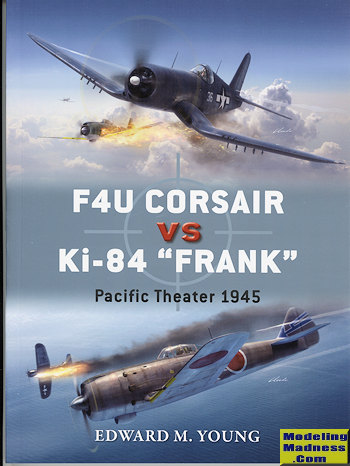 This latest
addition to Osprey's Duel series is a rather unlikely pairing. Not because
they were not contemporaries, for they very much were, but because of the
limited number of times they actually met each other in combat.
This latest
addition to Osprey's Duel series is a rather unlikely pairing. Not because
they were not contemporaries, for they very much were, but because of the
limited number of times they actually met each other in combat. |
Author: |
Edward M Young |
|
Publisher/Distributor |
Osprey Publishing |
|
Price |
$20.00 MSRP |
|
Reviewer: |
|
| Notes: |
80 pages, 7¼ x 9¼ inches, softcover ISBN: 978-1-4728-1460-9 |
 This latest
addition to Osprey's Duel series is a rather unlikely pairing. Not because
they were not contemporaries, for they very much were, but because of the
limited number of times they actually met each other in combat.
This latest
addition to Osprey's Duel series is a rather unlikely pairing. Not because
they were not contemporaries, for they very much were, but because of the
limited number of times they actually met each other in combat.
The Corsair was the first American naval fighter to exceed 400 mph in a straight line, while the Ki-84 was the first really potent IJAAF fighter. The Corsair had been in unit service since early 1943, while the Ki-84 first started reaching combat units in late 1944.
By the time the Ki-84 was entering service, the Corsair had been with the fleet for quite some time and had proven its abilities. Though not racking up the kills of the Hellcat and not as easy to fly, the Corsair was a type that was used by some fleet squadrons and by pretty much all Marine fighter squadrons. It was with the Marines as much as anyone else that the Corsair earned its reputation.
The Japanese 'Hayate', was the result of learning from experience. This was an aircraft with a powerful engine, armor protection, good speed and handling, and armament that was as good as if not better than what the Corsair carried.
However, there were several situations to the detriment of the Japanese. First of all, US bombing severely hampered the ability to produce the aircraft as airframe and engine factories were frequently under attack. Secondly, a lack of strategic materials meant that it was difficult to produce a lot of aircraft. Finally, as powerful as the Ki-84's engine was, it had bugs in it caused by a lack of skilled workers, lack of skilled maintainers, and something that had plagued the Japanese military since the start of the war, a lack of spare parts.
All of this was exacerbated by a severe lack of experienced pilots. The war had taken its toll and the Japanese training regimen and lack of fuel meant that most of the pilots of these planes were woefully undertrained. In the hands of a master the Ki-84 was very potent, one ace shooting down two Corsairs in less than a minute. However, this was a rare case and most were shot down. It is estimated in the book that fewer than 20 separate meetings between the two types occurred. This was mostly from the Okinawa invasion until just before the end of the war. Franks were often the type used to escort suicide groups and that is where most Corsairs had combat with the Ki-84.
Typical of this series we get a development history of both types, information on the training of the crews as well as how the aircraft was deployed. This continues with quite a few action reports involving the two types. This latter item was difficult for researchers to ascertain. For one thing, US pilots had difficulty telling what they were shooting at since most Japanese planes were similar in set-up. Most also did not know of the existence of the Frank and thought they were Tojos. On the Japanese side, there were few records from which one could do research. This is enhanced by a lot of neat period photos, some nice art work and an interesting stats section at the end of the book. In all, it is a great read and a book that I can highly recommend to you.
April 2016
Copyright ModelingMadness.com
For more on the complete line of Osprey books, visit http://ospreypublishing.com. In the US, it is Osprey Direct at 443 Park Avenue South, New York, NY 10016, where you can get a catalogue of available books.
If you would like your product reviewed fairly and quickly, please contact me or see other details in the Note to Contributors.